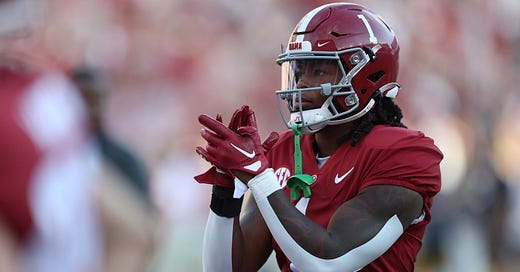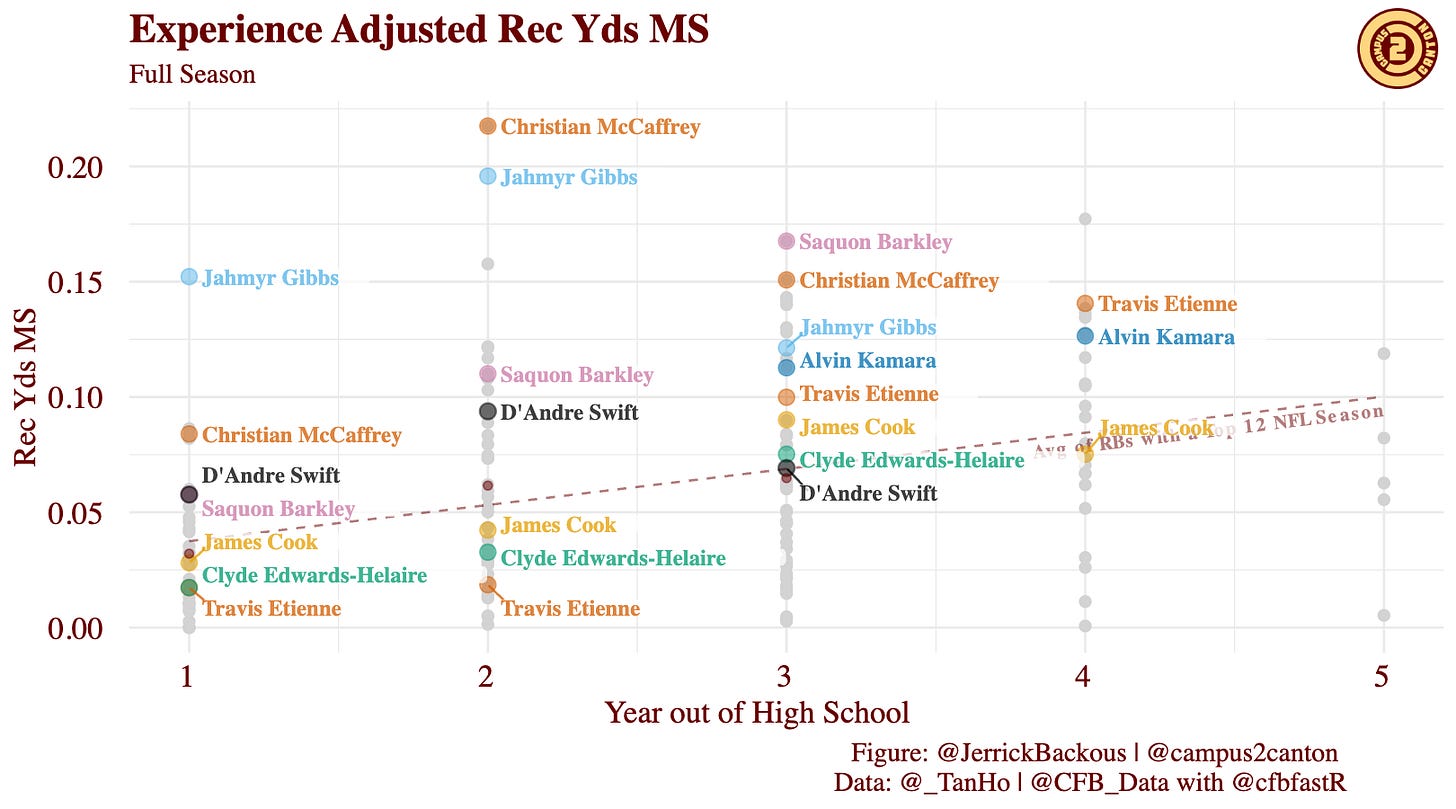I hate rankings.
Of all forms of content in the fantasy industry, I think rankings are both the easiest to write and the hardest to convey meaning with. Anyone who has ever ranked anything from fantasy assets to potato chip flavours knows it is impossible to perfectly capture the context associated with your list, or the broad array of contingencies attached to each placement.
Sure I’d rank salt and vinegar chips highly in most circumstances, but have you ever tried one after burning your gums on a piping hot pizza slice? Call a medic!
Anyhow, despite my distaste for rankings as a medium, and the knowledge that I’ll be shifting these substantially this weekend, I thought it would valuable to walk through my thoughts on the rookie class prior to the draft so we can establish a baseline to refer to when I publish my post-draft rookie draft content.
On that note, here is what you can expect from me over the next couple weeks:
I just finished my last ever law school paper today (hence this post) so it’s time to shift into draft overdrive.
Today’s piece will walk through some loose rookie draft tiers and thoughts on the state of the rookie class.
By Sunday I will have updated rookie tiers in your inbox with some early guesses on targets and avoids
After a few days to generate ADP data, I will publish my updated rookie tiers which feature two sets of ranks: (1) my “vacuum” ranks (where I would draft these players without any knowledge of the market’s preferences) and (2) my “action” ranks (where I am drafting players on average considering my ranks and the market’s preferences). I will update each list throughout the month as needed.
I aim to publish my Rookie Draft Walkthrough next week, in which I walk through each tier with an eye to how I’m planning to attack rookie drafts including spots I’m looking to trade up to, back from, or out of.
I will also re-publish my Heuristics for Rookie Drafts article with some updates to reflect the current year’s draft class and additional information I’ve picked up in the last year
Beyond that, I hope to do a mailbag type post where I field questions either from the comment section, twitter replies, and/or the Bulletproof Patreon discord and provide some answers to anything I may have missed or requiring further explanation from my posts
Without further ado, let’s get into today’s post! As you know, one of the driving principles behind this newsletter is the goal of developing winning strategies without necessarily out-evaluating the market. Therefore, I do not consider myself a one-stop shop for elite rookie evaluation takes.
In developing my ranks, I canvas three primary models I have a lot of respect for: Pat Kerrane’s rookie model, JJ Zachariason’s late round prospect guide, and Drew Osinchuk’s Bulletproof model. For running backs in particular, I blend in the models above with the work of Noah Hills, and my own film and data analysis (sourced primarily from campus2canton).
On the whole, I try to blend the evaluative processes of people in the industry I trust with historical ADP trends and my own market-based processes and player evaluations to make optimal bets at each point of rookie drafts.
Fair warning, I will not be deep diving into the full profile of every single prospect. If you do want deeper information on any prospect, I encourage you to start with the sources I highlighted above.
Note: These rankings are made with SuperFlex / PPR / 0.5 TEP / Start 11 dynasty leagues in mind. Feel free to adjust as needed for your own settings.
Last Note: I am expressing the value of each tier in “Base picks.” For more on that, check out this piece: effectively a “base” pick is a pick in the following year’s draft with an equal likelihood of slotting into any of the 12 positions.
Tier 1 (1.01) - Value: 2.5-3 Base 1s
Bijan Robinson, RB1 - Texas
There is little use wasting precious time extolling the virtues of Bijan Robinson. The guy is really good!
The University of Texas standout is one of the most well-rounded profiles you’ll see at the running back position, combining high-end rushing ability, a uniquely enticing receiving profile, and elite athleticism. Most importantly for fantasy purposes, he is a near-lock to hear his named called in the first round.
While his record-score in PFF’s elusive rating has led off 2023 rookie podcasts for months, one aspect of Robinson’s profile that may be slightly under-discussed is his receiving versatility. Noah Hills’ charting has Robinson at a 90th percentile ADOT of 3.0 and 93rd percentile Route Diversity.
On film, Robinson has the speed and technical ability to destroy linebackers on deep wheel routes and in the intermediate areas of the field, and possesses natural hands. Being a first round running back with workhorse size almost guarantees you low-end RB1 production in the recent NFL. But this receiving ability is where Bijan has a chance to separate and contend for RB1 overall for years to come.
Route Diversity has been an indicator of receiving ability that separates backs who are merely competent on all downs as swing pass absorbers and screen weapons vs. true, bona fide receiving weapons in any offense.
This may be a bizarre take for a player drafted at the 1-2 turn of startups before playing a down, but I think Bijan Robinson may be underrated. There is a notion pervasive in the dynasty world that his value ceiling is forever behind Ja’Marr Chase and Justin Jefferson due to the volatile nature of the Running Back position, but this fails to recall that just one year ago Jonathan Taylor was their ADP equal.
There is no safer bet than a Round 1 rookie RB for immediate volume. If Robinson’s prospect profile carries over, I think it is entirely likely he slots in right alongside Chase and Jefferson as the top non-QB assets in 2024 startups in the middle of the first round. While I would sell my 1.01s for Top 10 QBs such as Lamar Jackson, Deshaun Watson or Kyler Murray (you may be able to get some added here), I am also anxiously moving 1.02 / 1.03s + up to a late first of value for the privilege of adding Bijan Robinson to my teams, especially if ready to contend in short order.
Thus far, I’ve managed to sell Bijan on 4 teams (out of a total of 50) in deals for top 10 QBs, while acquiring Bijan himself on 4 other occasions; each of which from varying packages of young players, and draft picks. Compared to Chase or Jefferson, Robinson is unquestionably more liquid, and your best chance to acquire an asset of potentially exponential value without trading away an elite QB to do so.
Tier 2 (1.02-1.06) - Value: 1.5-2 Base 1s
Jahmyr Gibbs, RB2 - Alabama
Ranking Gibbs at 1.02 is perhaps my boldest take. However, due to that boldness, it is likely not a take I will put into action in many drafts unless he runs pure on draft night.
Nonetheless, here is the basis for my bullishness on Gibbs:
First off, his receiving profile is uniquely incredible. We know that the primary path to ‘legendary’ fantasy seasons come from running backs who amass extensive production in the passing game and that’s where GIbbs separates from the pack.
The two primary receiving metrics I utilize are Market Share of Receiving Yardage (MSRY) and Yards per Route Run. YPRR demonstrates the ability of the back to earn targets and create yardage on his opportunities, while MSRY combines yardage creation with the back’s overall volume of receiving production, demonstrating his team’s willingness to use him in passing situations.
Gibbs’ 19.6% best season MSRY was third in the class behind only Deuce Vaughn and Evan Hull - likely satellite backs in the NFL. For context, this is just shy of a commonly used threshold for wide receiver breakout seasons, and a higher share than the MSRY mark of Bijan Robinson and Zach Charbonnet put together, both of whom are discussed as plausible three-down NFL backs.
Here is Gibbs compared to a selection of recent, highly-drafted backs touted for their receiving ability coming out of college. With exception of Christian McCaffrey, he’s absolutely pacing these jamokes.
In addition to raw volume, Gibbs’ career YPRR of 2.47 ranked 4th behind just McCaffrey, Alvin Kamara, and Rachaad White (whose “career” started after transferring from JUCO) in Pat Kerrane’s prospect database.
Lastly, per Noah Hills’ database, Gibbs ran an “advanced” route (wheel, angle, out etc.) on at least 24.9% of dropbacks all three years in college, compared to the average of 16.5% for all FBS backs. In addition, while at Georgia Tech over his first two years, he was targeted at an 8.1% higher clip than the FBS average when running a wheel route, and ran them twice as often. His target rate on angle routes was more than double the FBS average and his rate of such routes was over seven times the FBS average. While this extreme usage declined at Alabama, he continued to hit over the 80th percentile in route diversity, and was targeted above the average rate on all advanced routes.
I’ve gone this long without mentioning Gibbs’ size and I suppose now is a good time to do so. At just 199 pounds, he could be the first sub-200 pound back drafted in the first round since C.J. Spiller in 2010. Given several analysts such as JJ Zachariason’s data-bases don’t extend to the days of Spiller, his comp lists are typically well below-par for a player of his caliber and market value.
He is set to join the following list of backs since 2005 drafted round 1 or 2 under 205 pounds with a MSRY over 10%.
Chris Johnson
C.J. Spiller
Reggie Bush
Isaiah Pead
Christian McCaffrey
Giovanni Bernard
Depending on how full your glass is you can take what you wish from this. On one hand, it’s not ideal to spend an early 1st round rookie pick on a player without more than one strong comp in the last decade. On the other, you may say it’s just been several years since a cohort of backs of Gibbs’ caliber with this type of profile were drafted.
At the end of the day, I rest with this. Gibbs’ receiving profile is inarguably special. Running Backs with legitimate 100+ target upside are extraordinarily rare commodities in dynasty. While concerns about his weight and early-down rushing ability are valid, they should not stop us from drafting him this year.
The market is extraordinarily optimistic regarding rookie running backs; even those for whom optimism is revealed to be misplaced. (What’s up Miles Sanders? How are you Kerryon Johnson?)
The most commonly thrown out “downside comp” for Gibbs proves this point. “What if Gibbs is just D’Andre Swift?” People ask. My response is that if Gibbs is able to provide an RB1 season and carry top-5 consensus RB value within his first two years the selection is a success. What you do with that asset at a later date is ultimately a separate choice we can make with more information than we have today.
You can catch JJ Zachariason and I debating Gibbs vs. Jaxon Smith-Njigba below, which fleshes out both sides of the argument in greater detail.
Keep reading with a 7-day free trial
Subscribe to Thinking About Thinking: A Fantasy Football Newsletter to keep reading this post and get 7 days of free access to the full post archives.






